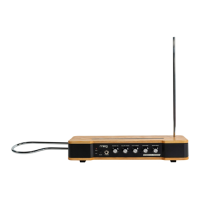20
CONTROLS AND FUNCTIONS (Continued)
ANTENNA FUNCTIONS
In the TUNING UP section of this manual (page 11), you already learned how to tune each of the
antennas for optimal performance. This section deals a bit more with what is actually changing
and being controlled as you adjust the antenna range knobs.
VOLUME RANGE
In the theremin world, generally the left hand is used to control the volume
and articulation of each note. Bringing the hand closer to the Volume
Antenna (the Loop Antenna) will decrease the volume, until eventually,
with the hand close to or inside the loop, there is no sound. Moving the
hand further away will increase the volume.
When adjusting the Volume Antenna Range, you are actually setting
the rate of volume change caused by your hand motion. That is, if you
want a finer control of soft attacks and dynamics, you might try a lower
(counterclockwise) value for the VOLUME RANGE knob. If you want to
play individual notes cleanly and with a firmer attack, rotate the VOLUME
RANGE knob in the clockwise direction.
PITCH RANGE
Conversely, the right hand is generally used to control the pitch of each
note. Bringing the hand closer to the Pitch Antenna will raise the pitch;
moving the hand (and/or fingers) further away will lower the pitch, until
eventually there is no sound. The PITCH RANGE knob allows the performer
to define a useful playing range by setting the pitch of the null point—that
is, the pitch that will sound when the performer’s hand, arm, or body is no
longer aecting the pitch.
Getting familiar with the Pitch Antenna response is probably the single
most important factor is developing a strong theremin technique. Use
the procedure described in the TUNING UP section of this manual, and
check this parameter each time you prepare to play. In time, you will be
comfortable tweaking the response during breaks in a performance or
session to achieve the best control.
Firmer
Attack
Softer
Attack
Slowly rotate clockwise
to find the “null point”

